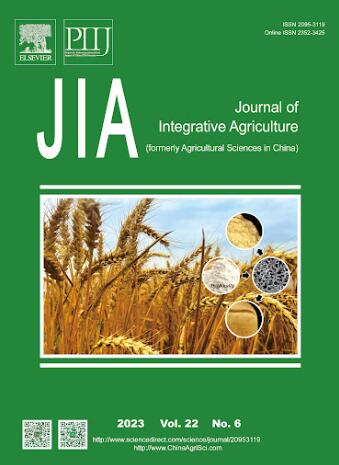在以 G. hirsutum 为背景的 Gossypium tomentosum CSSLs 中绘制纤维和种子相关性状的 QTL 图谱
IF 4.4
1区 农林科学
Q1 AGRICULTURE, MULTIDISCIPLINARY
引用次数: 0
摘要
将野生物种固有的遗传多样性引入栽培品种已成为作物遗传育种和遗传资源研究的热点之一。纤维和种子相关性状对全球经济和人民生活至关重要,在棉花育种中占据主要地位。本文利用野生棉花物种Ⅳ,拓宽了Ⅳ的遗传基础,并鉴定了纤维和种子相关性状的QTL。在.栽培品种背景下,用来自.的不同染色体片段建立了一个由 559 个染色体片段替代系(CSSLs)组成的群体。在三个产量性状、五个纤维品质性状和六个棉籽营养品质性状上分别鉴定出 72、89 和 76 个 QTLs。104 个 QTL 的有利等位基因由 .在两种或两种以上环境中鉴定出 64 个 QTL,并进一步鉴定出其中 3 个 QTL 的候选基因。本研究的结果有助于进一步研究这些经济性状形态发生的遗传基础,并表明......在改良......纤维和种子相关性状方面具有巨大的育种潜力。本文章由计算机程序翻译,如有差异,请以英文原文为准。
Mapping QTL for fiber- and seed-related traits in Gossypium tomentosum CSSLs with G. hirsutum background
Introducing the inherent genetic diversity of wild species into cultivars has become one of the hot spots in crop genetic breeding and genetic resources research. Fiber- and seed-related traits, which are critical to the global economy and people's livelihoods, occupy the principal status of cotton breeding. Here, a wild cotton species , was used to broaden the genetic basis of . and identify QTL for fiber- and seed-related traits. A population of 559 chromosome segment substitution lines (CSSLs) was established with various chromosome segments from . in a . cultivar background. A total of 72, 89, and 76 QTLs were identified for three yield traits, five fiber quality traits, and six cottonseed nutrient quality traits, respectively. Favorable alleles of 104 QTLs were contributed by . . Sixty-four QTL were identified in two or more environments, and candidate genes for three of them were further identified. The results of this study contributed to further study on the genetic basis of the morphogenesis of these economic traits, as well as indicating that the great breeding potentials of . in improving the fiber- and seed-related traits in . .
求助全文
通过发布文献求助,成功后即可免费获取论文全文。
去求助
来源期刊

Journal of Integrative Agriculture
AGRICULTURE, MULTIDISCIPLINARY-
CiteScore
7.90
自引率
4.20%
发文量
4817
审稿时长
3-6 weeks
期刊介绍:
Journal of Integrative Agriculture publishes manuscripts in the categories of Commentary, Review, Research Article, Letter and Short Communication, focusing on the core subjects: Crop Genetics & Breeding, Germplasm Resources, Physiology, Biochemistry, Cultivation, Tillage, Plant Protection, Animal Science, Veterinary Science, Soil and Fertilization, Irrigation, Plant Nutrition, Agro-Environment & Ecology, Bio-material and Bio-energy, Food Science, Agricultural Economics and Management, Agricultural Information Science.
 求助内容:
求助内容: 应助结果提醒方式:
应助结果提醒方式:


